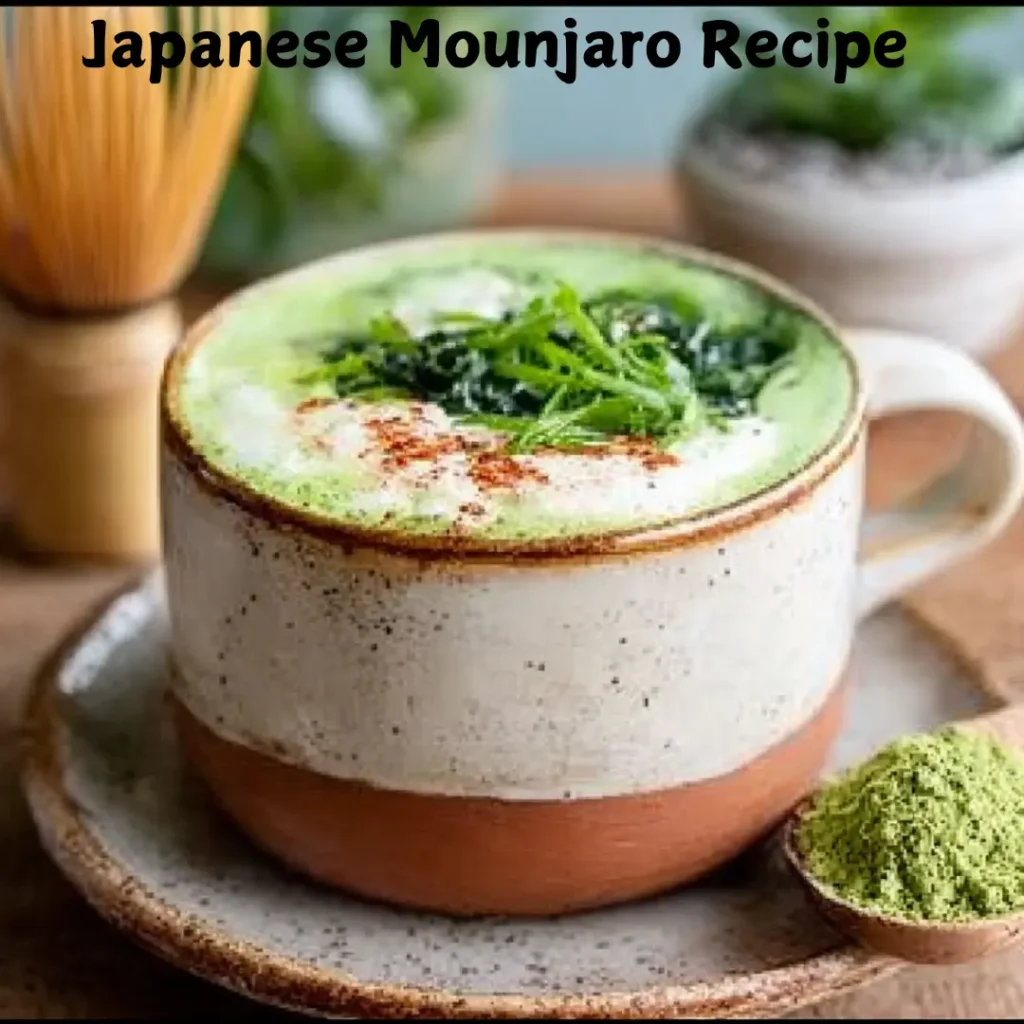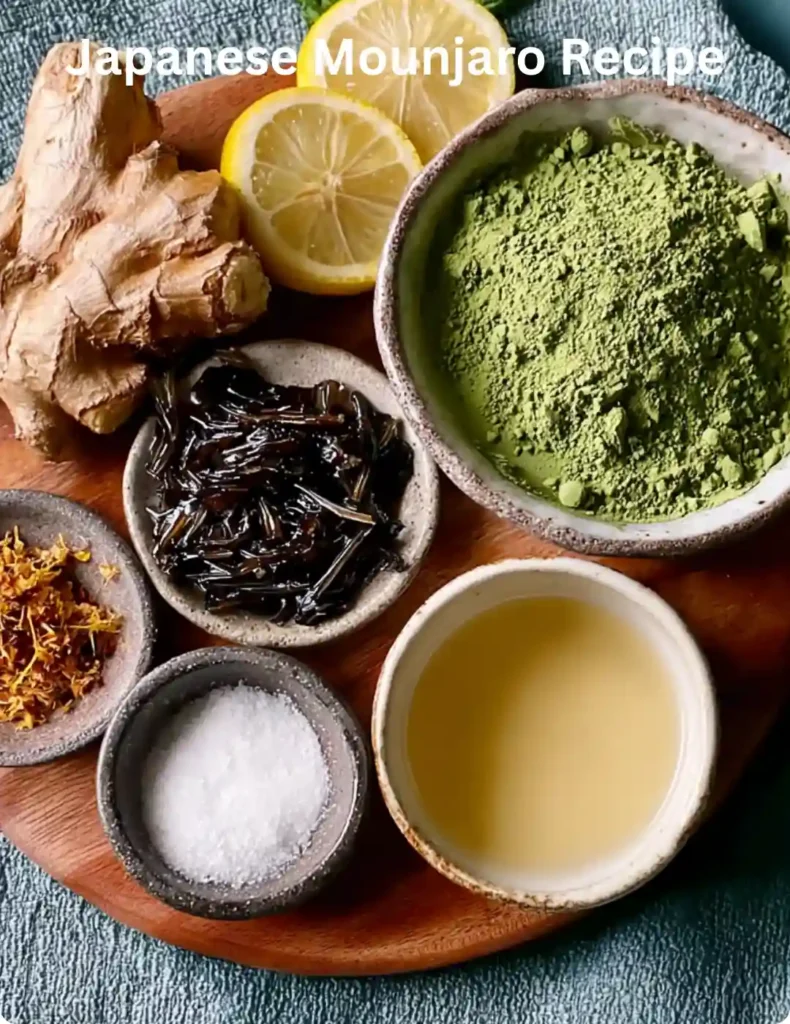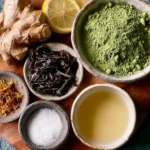What is the Japanese Mounjaro Recipe?
The Japanese Mounjaro recipe is a unique blend of natural ingredients rooted in Japanese culinary traditions, known for promoting metabolism, aiding digestion, and supporting overall wellness. Combining four key elements—matcha powder, umeboshi plum, kombu (dried kelp), and fresh ginger—this recipe harnesses the power of time-tested ingredients to help with natural weight loss while improving energy levels and digestion. Here’s a breakdown of each ingredient’s role and why they make the Japanese Mounjaro recipe so effective.

and lemon, offering a natural boost to your metabolism and digestion.
Table of Contents
Table of Contents
Why is the Japanese Mounjaro Recipe so Popular in Japan?
The Japanese Mounjaro recipe has become widely popular in Japan due to its combination of ancient, natural ingredients that promote overall health, balance, and weight loss. Rooted in centuries-old traditions and backed by modern wellness trends, this recipe is valued not only for its health benefits but also for its alignment with Japanese cultural practices surrounding food and wellness. Here’s why it has earned its place as a beloved health elixir in Japan:
1. Emphasis on Natural, Whole Ingredients
Japanese cuisine has long celebrated natural, nutrient-dense ingredients that are minimally processed.
The Japanese Mounjaro recipe aligns perfectly with this philosophy, using four core ingredients—matcha powder, umeboshi plum, kombu (dried kelp), and fresh ginger—that are both locally sourced and packed with health benefits. These ingredients are known for their anti-inflammatory, metabolism-boosting, and digestive-supporting properties, making them a natural choice for anyone looking to improve their health.
PrintJapanese Mounjaro Recipe: Traditional & Natural Variations You Must Try
Japanese Mounjaro is a refreshing, health-boosting beverage that combines the powerful flavors of matcha, ginger, and lemon with the natural sweetness of honey. This vibrant drink is known for its metabolism-boosting and digestion-supporting benefits, making it a great choice for those looking to improve overall wellness. The rich green matcha powder provides a natural energy boost, while ginger helps soothe the stomach and reduce bloating. The addition of lemon adds a refreshing zing, and honey offers a balanced sweetness. Easy to prepare in just 15 minutes, Japanese Mounjaro can be enjoyed hot or chilled, making it a versatile drink for any time of day.
- Prep Time: 10 MN
- Cook Time: 5 mn
- Total Time: 15 mn
- Yield: 1 pers 1x
- Category: drinks
- Method: EASY
- Cuisine: japanesse
- Diet: Low Fat
Ingredients
Ingredients:
1 teaspoon matcha powder
1 tablespoon dried tea leaves (green or black tea)
1 small piece of fresh ginger (grated)
1 teaspoon honeycomb (or honey)
2–3 lemon slices
1 cup hot water (about 200°F)
Instructions
Instructions:
Prepare the tea base: In a small bowl, whisk 1 teaspoon of matcha powder with hot water until smooth and frothy.
Brew the tea: In another cup, steep the dried tea leaves (green or black tea) in hot water for 3-5 minutes, depending on the desired strength.
Add ginger and honey: Grate a small piece of fresh ginger into the tea and stir in honey or honeycomb to taste.
Combine: Pour the matcha into the tea and stir well. Add lemon slices for a refreshing citrusy zing.
Serve: Serve the Japanese Mounjaro hot or chilled, as desired. Enjoy the health benefits!
Serving Suggestions:
Serve with extra lemon slices or a sprig of mint for added freshness.
Enjoy as a morning energy boost or as an afternoon digestive aid
Notes
Benefits:
Boosts metabolism: Matcha and ginger work together to enhance metabolism and promote fat burning.
Supports digestion: Ginger aids in digestion and helps to reduce bloating.
Balances energy: The combination of matcha and tea provides a sustained energy boost without jitters.
Rich in antioxidants: Matcha is packed with antioxidants to promote overall health and wellness.
Nutrition
- Serving Size: 1 prs
2. Balance and Harmony in Food
In Japan, balance is key to a healthy lifestyle, and food plays a critical role in achieving this. The Japanese Mounjaro recipe embodies this principle by incorporating ingredients that balance each other out. Matcha provides an energy boost without jitters, while umeboshi plum’s tartness helps calm digestion. Kombu enhances metabolism, and ginger promotes digestion and reduces bloating. Together, these ingredients work in harmony to support both mental and physical well-being.
3. Holistic Approach to Health and Weight Loss
Japan has a long history of promoting wellness through natural remedies, and the Japanese Mounjaro recipe fits into this holistic approach. It’s seen not just as a weight loss solution, but as a wellness ritual that enhances overall health. The benefits of the ingredients extend beyond just fat-burning: they support digestion, boost energy, reduce inflammation, and aid detoxification, helping people maintain a sense of vitality and balance in their daily lives. As such, it’s a multifunctional recipe that is appealing to anyone looking to improve their overall health.
4. Ancient Traditions with Modern Relevance
While the ingredients used in the Japanese Mounjaro recipe have been consumed for centuries, the combination of these ingredients in this particular recipe has gained modern popularity. The increasing interest in natural weight loss methods and holistic health solutions has brought this traditional recipe into the spotlight. In recent years, as people in Japan and around the world become more conscious of the impact of processed foods and artificial chemicals, the Japanese Mounjaro recipe provides a natural, nourishing alternative for health-conscious individuals.
5. Popularity in Traditional and Modern Wellness Circles
Japanese Mounjaro has found a place in both traditional and modern wellness practices. In Japan, it’s not uncommon for people to incorporate natural remedies and ingredients into their everyday routines to promote longevity and mental clarity. The recipe is embraced in both the home kitchen and by wellness professionals who recommend it as part of a balanced, detoxifying diet. As global interest in matcha and other traditional Japanese superfoods continues to rise, the Mounjaro recipe has become a trendy choice for health enthusiasts worldwide.
6. A Quick, Easy, and Effective Health Boost
In today’s busy world, Japanese people appreciate solutions that are both effective and easy to incorporate into their daily routine. The Japanese Mounjaro recipe is simple to make and provides a quick, accessible way to boost metabolism, enhance digestion, and enjoy the numerous benefits of the ingredients. It can be consumed in many forms—whether as a hot tea, cold smoothie, or an energy-boosting snack—making it both versatile and easy to integrate into a busy lifestyle.
7. Cultural Appreciation of Tea and Natural Beverages
Japan has a long-standing appreciation for tea culture and the many health benefits of natural beverages. The popularity of matcha in particular, with its grounding, calming properties and metabolism-boosting effects, makes the Japanese Mounjaro recipe a perfect fit in the context of Japan’s tea traditions. The combination of matcha with umeboshi and ginger offers a refreshing twist on traditional tea practices while still maintaining the essence of what makes Japanese tea culture so revered.well-rounded meal
Key Natural Ingredients & Their Benefits
The effectiveness of Japanese Mounjaro lies in its unique blend of four time-honored natural ingredients. Each one plays a distinct role in supporting the body, working synergistically to promote natural weight loss and enhance metabolism. Here’s a closer look at the key ingredients and how they contribute to the process:
| Ingredient | Function | Weight Loss Benefit |
|---|---|---|
| Matcha Powder | Rich in EGCG antioxidants | Boosts metabolism and accelerates fat burning |
| Umeboshi Plum | Fermented for digestive balance | Reduces bloating and curbs cravings |
| Kombu (Dried Kelp) | A rich source of iodine and essential minerals | Supports thyroid function and optimizes fat utilization |
| Fresh Ginger | Known for its anti-inflammatory properties | Aids digestion and helps reduce water retention |
These powerful ingredients, when combined, offer a holistic approach to natural weight loss by improving metabolism, digestion, and overall wellness.

including matcha powder, ginger, lemon, and honey, all known for their health benefits.
Preparation and Cooking Techniques for Japanese Mounjaro Recipe
Step-by-Step Guide to Preparing the Japanese Mounjaro recipe
Cooking Tips to Perfect Your Japanese Mounjaro
To get the most out of your Japanese Mounjaro, it’s essential to incorporate these key ingredients properly into your diet. Whether you’re blending them into smoothies, teas, or using them in cooking, here are some tips for perfecting your Japanese Mounjaro:
- Matcha Powder
- Tip: When preparing your matcha, whisk it into hot water or plant-based milk for a smooth, creamy texture. Avoid boiling the water, as high heat can diminish the antioxidant properties of matcha.
- Usage: Add it to smoothies or blend with lemon juice for a refreshing drink that boosts metabolism.
- Umeboshi Plum
- Tip: Use umeboshi plums in small amounts, as their tartness can be quite potent. They pair wonderfully with rice, salads, and even as a garnish for soups or noodles.
- Usage: For weight loss, incorporate a small piece of umeboshi in your salad dressing or stir it into soups to reduce bloating and curb cravings.
- Kombu (Dried Kelp)
- Tip: Kombu is best used in soups or broths. You can simmer it in water to create a savory base, which enhances the iodine and minerals it offers. Be sure to remove it after simmering, as it can become too tough to eat.
- Usage: Use kombu to create a nutritious broth for noodle soups or stews. It helps support thyroid function and enhances fat metabolism.
- Fresh Ginger
- Tip: Fresh ginger is most potent when used raw, but it can also be added to cooking or tea. Grate it finely for quicker absorption and a more intense flavor.
- Usage: To reduce water retention and aid digestion, add fresh ginger to your morning tea, blend it into smoothies, or grate it into stir-fries for added zest and anti-inflammatory benefits.
By incorporating these ingredients thoughtfully, you can enhance both the flavor and the health benefits of your Japanese Mounjaro, helping you achieve natural weight loss while enjoying delicious meals.
Exploring Variations of the Japanese Mounjaro Recipe
Regional Variations of Mounjaro
While the base Japanese Mounjaro recipe remains consistent, various regions in Japan offer their unique spins on the dish. These regional differences often stem from the availability of local ingredients or traditional preferences. Here are a few regional variations of Mounjaro that you can try:
- Kyoto-Style Mounjaro:
Kyoto, known for its refined and seasonal cuisine, often incorporates a more delicate broth in its Japanese Mounjaro recipe. Here, dashi might be prepared with lighter kombu and skip the bonito flakes for a more subtle umami flavor. Vegetables like kabocha squash or shungiku (edible chrysanthemum leaves) are commonly used, adding a slightly sweet and floral note to the dish. - Hokkaido-Style Mounjaro:
In the colder northern regions like Hokkaido, where winters are long and harsh, The Japanese Mounjaro recipe can take a heartier form. Beef is more frequently used as the protein source, and the broth is richer, often enhanced with miso for depth. This variation reflects the need for warming, substantial meals that provide both comfort and nutrition during the cold months. - Okinawan Mounjaro:
Okinawa, with its subtropical climate, tends to favor lighter, fresh ingredients. Fish like tuna or mackerel are more commonly featured, and the vegetables used tend to include seaweed, like kombu or wakame, for an added oceanic flavor. The broth might also incorporate a touch of citrus, such as yuzu or lime, to give a refreshing twist to the traditional Mounjaro. - Tokyo-Style Mounjaro:
In Tokyo, The Japanese Mounjaro recipe is usually a straightforward but hearty dish. Commonly served with a variety of root vegetables like carrots, potatoes, and daikon, the Tokyo version often includes chicken as the protein, along with a rich dashi-based broth enhanced with soy sauce and a hint of mirin. This simple yet filling version represents the bustling nature of the capital.
Serving and Pairing the Japanese Mounjaro Recipe
Serving and Pairing the Japanese Mounjaro Recipe
To maximize the benefits and flavor of Japanese Mounjaro, pairing it with the right dishes and serving it in an enjoyable way is key. Here are some ideas for serving and pairing your Japanese Mounjaro recipe:
1. Ideal Serving Options
- Matcha Smoothie Bowl: Serve your Japanese Mounjaro blend as a smoothie bowl topped with fresh fruits, seeds, and a drizzle of honey. The creamy texture of matcha blends well with the subtle tartness of umeboshi and the freshness of ginger.
- Hot or Iced Drink: You can serve it as a hot beverage, especially in the winter months, or enjoy it as a refreshing iced drink in the summer. Both ways will help boost your metabolism and provide the antioxidant benefits of matcha.
- As a Tea: If you prefer a simpler preparation, steep the matcha powder in hot water for a pure, potent tea. Add a bit of umeboshi plum for a touch of tangy flavor, balancing out the bitterness of the matcha.
2. Pairing Ideas
- With Japanese Dishes: The natural ingredients in Japanese Mounjaro work perfectly with other Japanese foods. Pair it with miso soup, sushi, or vegetable tempura for a complete meal. The minerals in kombu and the digestive support from ginger complement the lightness and freshness of these dishes.
- With Whole Grains: Mounjaro pairs wonderfully with brown rice or quinoa. The fermented umeboshi plum is particularly good when paired with these grains, helping to reduce bloating while providing a balanced meal.
- Fresh Salads: Add a light salad made with seaweed (like wakame) or cucumber, topped with a dressing made from umeboshi plum and a bit of fresh ginger. This combination promotes digestion while enhancing your weight-loss efforts.
- With Grilled Fish: Pair your Mounjaro drink with grilled fish like salmon or mackerel for a hearty and satisfying meal. The iodine from the kombu and the omega-3s from the fish will complement each other, supporting metabolism and overall health.
3. Dessert Pairings
- Matcha-Flavored Desserts: Pair your Japanese Mounjaro with matcha-flavored desserts, such as matcha ice cream, matcha-flavored mochi, or even matcha cakes. The antioxidant properties of matcha will complement the sweetness of these treats while keeping the overall meal light.
- Ginger Cookies: Since fresh ginger is a part of the recipe, pairing it with soft, chewy ginger cookies makes for a delicious and satisfying treat that also aids digestion.
4. When to Serve
- Morning Kickstart: Enjoy your Japanese Mounjaro in the morning to boost your metabolism and jumpstart your day with an energy-packed beverage.
- Post-Meal Digestive Aid: If you’ve had a heavy meal, serving Japanese Mounjaro as a post-meal drink helps with digestion, reduces bloating, and calms cravings, making it an ideal evening drink.
5. Enhancing the Experience
- Presentation: Serve your Japanese Mounjaro in traditional Japanese cups or tea bowls for an authentic touch. You can also garnish your drink with a slice of fresh ginger or a piece of umeboshi plum on the side to make it visually appealing.
- Mindful Eating: Take time to enjoy the flavors. The bitterness of the matcha, the umami from kombu, the tartness of the umeboshi, and the warmth of ginger come together in a balanced and health-boosting experience.
By thoughtfully pairing your Japanese Mounjaro recipe with the right foods and serving it creatively, you can enjoy a balanced and effective meal that supports your health and weight loss goals.
for more recipes follow me on pinterest and facebook

and lemon, offering a natural boost to your metabolism and digestion.
Conclusion: Mastering the Art of Japanese Mounjaro
Mastering the art of Japanese Mounjaro means embracing a tradition of natural wellness that has stood the test of time. This recipe, rich in powerful ingredients like matcha powder, umeboshi plum, kombu, and fresh ginger, offers a holistic approach to health by improving metabolism, boosting digestion, and enhancing overall vitality.
The beauty of Japanese Mounjaro lies in its simplicity and versatility. Whether consumed as a hot tea, refreshing iced beverage, or blended into a smoothie bowl, it seamlessly integrates into various aspects of your daily routine. Its carefully chosen ingredients work together to support your body’s natural processes, helping you feel energized, balanced, and healthy.
By mastering this recipe, you not only tap into a potent natural remedy for weight loss and digestion but also become part of a long-standing cultural tradition that prioritizes wellness, longevity, and balance. It’s a reminder that simple, wholesome ingredients are often the best way to nourish your body and mind. So, whether you’re new to Japanese wellness or a seasoned enthusiast, Japanese Mounjaro provides a unique, effective, and enjoyable way to improve your health and embrace the essence of Japanese vitality.
Take the time to savor each ingredient and enjoy the myriad of health benefits they bring. With the Japanese Mounjaro recipe, you’re not just making a beverage—you’re engaging in a wellness ritual that aligns your body and mind for long-term health.
FAQs about Japanese Mounjaro Recipe
1. What are the ingredients in the Japanese Mounjaro?
The Japanese Mounjaro typically includes protein (like tofu, chicken, or fish), a variety of root vegetables (such as potatoes, carrots, and daikon), leafy greens (like spinach or shungiku), and a flavorful broth made from miso, dashi, or soy sauce. You can also add seasonings like ginger, garlic, and sesame oil for extra flavor.
2. What is the natural version of Mounjaro?
The natural version of Mounjaro focuses on using all-natural, plant-based ingredients, including fresh vegetables, tofu, and a vegetarian-friendly dashi made from kombu (seaweed) or shiitake mushrooms. It eliminates any processed ingredients, focusing solely on the flavors of nature’s bounty.
3. Is Japanese Mounjaro healthy?
Yes! Japanese Mounjaro is a healthy dish. It’s rich in vitamins, minerals, and fiber from the vegetables, protein from tofu or fish, and contains healthy fats if made with ingredients like sesame oil. The broth is light but flavorful, and the dish can be adjusted to suit different dietary needs, such as vegan, low-sodium, or gluten-free options.
. Can I add noodles to my Mounjaro?
Yes, you can add noodles like soba or udon to your Mounjaro to make it more filling. Simply add the noodles towards the end of the cooking process and let them absorb the rich broth for an extra comforting meal.

